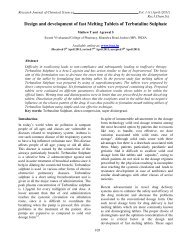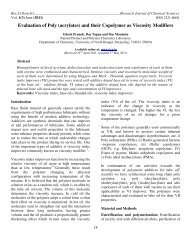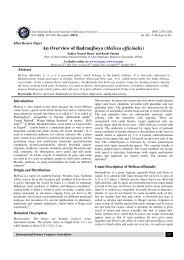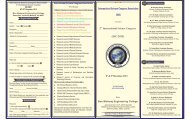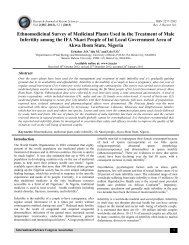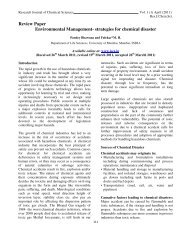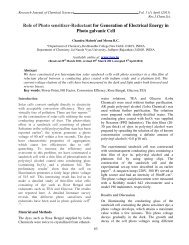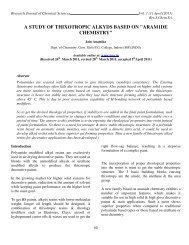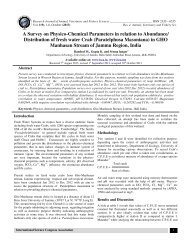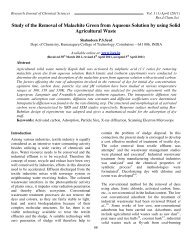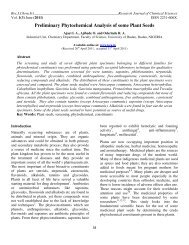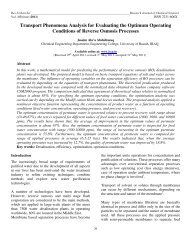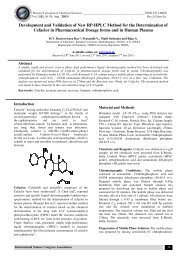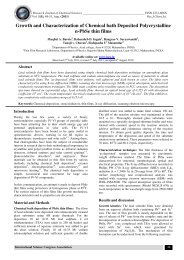A Simple and Efficient Procedure for Synthesis of Biologically ... - ISCA
A Simple and Efficient Procedure for Synthesis of Biologically ... - ISCA
A Simple and Efficient Procedure for Synthesis of Biologically ... - ISCA
Create successful ePaper yourself
Turn your PDF publications into a flip-book with our unique Google optimized e-Paper software.
Research Journal <strong>of</strong> Chemical Sciences Vol. 1 (1) April (2011)<br />
Res.J.Chem.Sci.<br />
A <strong>Simple</strong> <strong>and</strong> <strong>Efficient</strong> <strong>Procedure</strong> <strong>for</strong> <strong>Synthesis</strong> <strong>of</strong> <strong>Biologically</strong> Active 1,2,4-<br />
Triazolo-[3,4-b]-1,3,4-thiadiazole -2-aryl-thiazolidine-4-one Derivatives<br />
Abstract<br />
Parmar Kokila *, Prajapati Sarju, Patel Rinku, Patel Rekha,<br />
Department <strong>of</strong> Chemistry,<br />
Hemch<strong>and</strong>racharya North Gujarat University, Patan-384265, INDIA<br />
Available online at: www.isca.in<br />
(Received 21 st March 2011, revised 25 th March 2011, accepted 30 th March 2011)<br />
Some new <strong>and</strong> biologically active [1,2,4] triazolo [3,4-b][1,3,4] thiadiazole-2-aryl-thiazolidinone-4-ones<br />
were synthesized by reaction <strong>of</strong> Schiff bases with mercapto acetic acid in presence <strong>of</strong> THF with adding<br />
anhydrous ZnCl 2 . The structure <strong>of</strong> the synthesized compounds have been estabilished on the bases <strong>of</strong> IR,<br />
PMR, CMR <strong>and</strong> elemental analysis. The compounds have been evaluated <strong>for</strong> antibacterial activity<br />
against B. subtilis, S. aureus, P. aeruginosa <strong>and</strong> E. coli.<br />
Key words: <strong>Synthesis</strong>, Biological activity,Triazolo, Thiadiazole, thiazolidinones<br />
Introduction<br />
In the last few decades, the chemistry <strong>of</strong> heterocycles<br />
bearing a triazole or 1,3,4-thiadiazole moiety are<br />
reported to show a wide spectrum <strong>of</strong> biological<br />
activity 1-8 such as antibacterial 9 , anti aggregatory<br />
agent 10 , antiviral 11 <strong>and</strong> anti-inflammatory 12 activities.<br />
In addition, the N-bridged heterocycles derived from<br />
1,2,4-triazoles have applications in field <strong>of</strong> medicine,<br />
agriculture <strong>and</strong> industry. 13 1,3,4-Thiadiazoles exhibit<br />
broad spectrum <strong>of</strong> biological activites possibly due<br />
to the presence <strong>of</strong> toxophoric N-C-S moiety 14 . They<br />
found applications as antibacterial, antitumor, anti<br />
inflammatory agents, pesticides, herbicides, dyes,<br />
lubricants <strong>and</strong> analytical reagents. 15 The [1,2,4]-<br />
triazolo-[3,4-b]-[1,3,4]-thiadiazole derivatives<br />
obtained by fusing the biolibale [1,2,4]-triazole <strong>and</strong><br />
[1,3,4]-thiadiazole ring together, are reported to<br />
possess anti bacterial, antifungal, CNS depressant,<br />
anti viral, analgesic <strong>and</strong> plant growth regulatory<br />
effects. 16 In literature revealed, some derivatives <strong>of</strong><br />
[1,2,4]-triazolo-[3,4-b]-[1,3,4]-thiadiazoles have<br />
been show as optically active with L-Amino acid. 17<br />
The 4-carbonyl derivative <strong>of</strong> thiazolidine is known<br />
as 4-thiazolidinone. 4-thiazolidinones have been well<br />
studied <strong>and</strong> a variety <strong>of</strong> biological activities have<br />
been reported <strong>for</strong> a large number <strong>of</strong> their derivatives.<br />
Suchasantibacterial 18 , antimicrobial 19 , anti fungal 20 ,<br />
18<br />
anti anthelmintic 21 , anti infiammatory 22 , anti<br />
tubercular 23 <strong>and</strong> diuretic agents 24 , anti thyroid 25 <strong>and</strong><br />
as a local anaesthetic .<br />
We report here in the reaction <strong>of</strong> Schiff bases with<br />
mercapto acetic acid in presence <strong>of</strong> THF with adding<br />
anhydrous ZnCl 2 to give biologically active [1,2,4]<br />
triazolo [3,4-b][1,3,4] thiadiazole-2-arylthiazolidinone-4-ones<br />
with the hope <strong>of</strong> to obtained<br />
compounds with good yield.<br />
Material <strong>and</strong> Methods<br />
Melting points were determined using an electro<br />
thermal digital apparatus <strong>and</strong> are uncorrected. Purity<br />
<strong>of</strong> the compound was checked by thin layer<br />
chromatography (TLC). IR spectra were prepared on<br />
a FT-IR spectrophotometer using KBr discs. 1 H<br />
PMR spectra were recorded on Bruker<br />
spectrophotometer (300 MHz) in DMSO-d 6 or<br />
CDCl 3 using TMS as an internal st<strong>and</strong>ard.<br />
<strong>Synthesis</strong> <strong>of</strong> methyl benzoate (1): Benzoic acid<br />
(0.01 mole) in 20 ml <strong>of</strong> methanol <strong>and</strong> 0.5 ml conc.<br />
Sulfuric acid was refluxed <strong>for</strong> 12 hrs. <strong>and</strong> poured<br />
into ice. The product was isolated <strong>and</strong> treated with<br />
st<strong>and</strong>ard sodium bicarbonate solution to give desired<br />
compounds.
Research Journal <strong>of</strong> Chemical Sciences Vol. 1 (1) April (2011)<br />
Res.J.Chem.Sci.<br />
<strong>Synthesis</strong> <strong>of</strong> benzoic acid hydrazide (2): A mixture<br />
methyl benzoate (0.01 mole) <strong>and</strong> hydrazine hydrate<br />
(0.5 g, 0.01 mole) was heated <strong>for</strong> 9 hrs. <strong>and</strong> poured<br />
into ice. The product was isolated <strong>and</strong> crystallized<br />
from ethanol.<br />
<strong>Synthesis</strong> <strong>of</strong> potassium-benzoic acid hydrazide<br />
dithiocarbamate (3): A mixture <strong>of</strong> benzoic acid<br />
hydrazide (0.01 mole), KOH (0.84 g, 0.015 mole)<br />
<strong>and</strong> 1.5 ml CS 2 in absolute alcohol was stirred <strong>for</strong> 21<br />
hrs. <strong>and</strong> product was isolated from diethyl ether.<br />
<strong>Synthesis</strong> <strong>of</strong> 4-amino-5-phenyl-4H-1,2,4-triazole-<br />
3-thiol (4): Potassium salt (0.01 mole) was taken in<br />
hydrazine hydrate <strong>and</strong> heated up to the evolution <strong>of</strong><br />
H 2 S gas cussed nearly 5 hrs. in oil bath. The reaction<br />
mixture was poured into crushed ice <strong>and</strong> treated with<br />
glacial Acetic acid .The product was filtered <strong>and</strong><br />
purified by KOH treatment <strong>and</strong> crystallized from<br />
ethanol.<br />
<strong>Synthesis</strong> <strong>of</strong> 3-(phenyl)-6-(4-N-acetylamino<br />
phenyl) [1,2,4]triazolo[3,4-b][1,3,4]thiadiazole (5):<br />
A mixture <strong>of</strong> n-acetyl-p-amino benzoic acid (0.01<br />
mole) <strong>and</strong> 4-amino-5-phenyl-4H-1,2,4-triazole-3-<br />
thiol (0.01 mole) in POCl 3 (25 ml) was refluxed <strong>for</strong><br />
10 hrs. The reaction mixture was poured into crushed<br />
ice <strong>and</strong> thus solid separated out was filtered, washed<br />
with water <strong>and</strong> crystallized from ethanol.<br />
<strong>Synthesis</strong> <strong>of</strong> 3-(phenyl)-6-(4-amino phenyl)<br />
[1,2,4]triazolo[3,4-b][1,3,4]thiadiazole (ATT) (6):<br />
3-(phenyl)-6-(4-N-acetylamino phenyl) [1,2,4]<br />
triazolo[3,4-b][1,3,4]thiadiazole was hydrolysed by<br />
refluxing with 75 ml <strong>of</strong> ethanol containing 15 ml <strong>of</strong><br />
concentrated HCl <strong>for</strong> 4-5 hrs. it was then poured into<br />
ice-cold water <strong>and</strong> finally made just alkaline with<br />
liquid ammonia. The resultant product 3-(phenyl)-6-<br />
(4-amino phenyl) [1,2,4] triazolo [3,4-b] [1,3,4]<br />
thiadiazole (ATT) is filtered <strong>of</strong>f <strong>and</strong> washed with<br />
water <strong>and</strong> air dried. It was then recrystallised from<br />
ethanol.<br />
<strong>Synthesis</strong> <strong>of</strong> Arylidine-[3,6-(diphenyl)-<br />
[1,2,4]triazolo[3,4-b][1,3,4]thiadiazole] (7a-h): A<br />
mixture <strong>of</strong> equimolar amount <strong>of</strong> 3-(phenyl)-6-(4-<br />
amino phenyl) [1,2,4]triazolo[3,4-b][1,3,4]thiadiazole<br />
19<br />
(0.01 mole) <strong>and</strong> various aromatic aldehydes<br />
(0.01mole) in 50 ml acetic acid <strong>and</strong> refluxed <strong>for</strong> about<br />
10-12 hrs. on oil bath. The reaction mixture was<br />
cooled <strong>and</strong> it was poured in to ice water <strong>and</strong> extracted<br />
with ethyl acetate <strong>and</strong> water <strong>and</strong> finally dried over<br />
anhydrous sodium sulfate. The solvent was evaporated<br />
to give the solid product. It was crystallized from ethyl<br />
acetate hexane using decolorizing charcoal to give<br />
various anils<br />
<strong>Synthesis</strong> <strong>of</strong> 3-[(3,6-diphenyl)-[1,2,4]triazolo[3,4-<br />
b][1,3,4]thiadiazole]-2-aryl-thiazolidine-4-ones (8ah):<br />
A mixture <strong>of</strong> Schiff bases (7a-h) (0.01 mole ) in<br />
THF (30 ml) <strong>and</strong> mercapto acetic acid (thioglycolic<br />
acid) (0.01 mole) with a pinch <strong>of</strong> anhydrous ZnCl 2<br />
was refluxed <strong>for</strong> 12 hours. The solvent was then<br />
removed to get a residue, which was dissolved in<br />
benzene <strong>and</strong> passed through column <strong>of</strong> silica gel using<br />
benzene : chloro<strong>for</strong>m (8:2;v/v) mixture as eluent. The<br />
eluate was concentrated <strong>and</strong> the product crystallized<br />
from alcohol to give 4-thiazolidinones(8a-h).<br />
Spectral Analysis <strong>of</strong> Synthesized compounds (8ah)<br />
(1) 3-[(3,6-diphenyl)-[1,2,4]triazolo[3,4-b][1,3,4]-<br />
thiadiazole]-2-phenyl-thiazolidin-4-one (8a): I.R.<br />
(KBr, cm-1): 3030, 1500 (aromatic C-H), 1600, 1680<br />
(C=O <strong>of</strong> thiazolidinone). PMR (δ ppm): 6.12-7.8 (m,<br />
aromatic), 3.1 (2H <strong>of</strong> CH 2 <strong>for</strong> thiazolidinone), 5.35<br />
(H <strong>of</strong> C 2 H <strong>for</strong> thiazolidinone). 13 CMR (δ ppm): 113-<br />
130 (benzene),136-145 (triazolo-thiadiazole), 169<br />
(C=O), 36 (CH 2 ), 46 (CH).<br />
(2) 3-[(3,6-diphenyl)-[1,2,4]triazolo[3,4-b][1,3,4]-<br />
thiadiazole]-2-(4-methoxyphenyl)-thiazolidin-4-<br />
one (8b): I.R. (KBr, cm-1): 3030, 1500 (aromatic C-<br />
H), 1600, 1690 (pyridine ring, C=O <strong>of</strong><br />
thiazolidinone), 1200 (Ar-O-CH 3 ). PMR (δ ppm):<br />
6.12-7.8 (m, aromatic), 3.2 (2H <strong>of</strong> CH 2 <strong>for</strong><br />
thiazolidinone), 5.35 (H <strong>of</strong> C 2 H <strong>for</strong> thiazolidinone),<br />
3.35 (3H <strong>of</strong> CH 3 <strong>of</strong> thiazolidinone). 13 CMR (δ ppm):<br />
113-131 (benzene),135-145 (triazolo-thiadiazole),<br />
169 (C=O), 36 (CH 2 ), 46 (CH), 56 (CH 3 ).<br />
(3) 3-[(3,6-diphenyl)-[1,2,4]triazolo[3,4-<br />
b][1,3,4]-thiadiazole]-2-(4-hydroxyphenyl)-<br />
thiazolidin-4-one (8c): I.R. (KBr, cm-1): 3030,
Research Journal <strong>of</strong> Chemical Sciences Vol. 1 (1) April (2011)<br />
Res.J.Chem.Sci.<br />
1500 (aromatic C-H), 1600, 1690 (C=O <strong>of</strong><br />
thiazolidinone), 3200-2600 (broad, OH stretching),<br />
2880, 2920 (CH 2 stretching). PMR (δ ppm): 6.12-<br />
7.8 (m, aromatic), 3.2 (2H <strong>of</strong> CH 2 <strong>for</strong><br />
thiazolidinone), 5.35 (H <strong>of</strong> C 2 H <strong>for</strong> thiazolidinone),<br />
3.9 (H <strong>of</strong> OH).<br />
13 CMR (δ ppm): 113-132<br />
(benzene),135-145 (triazolo-thiadiazole), 169 (C=O),<br />
36 (CH 2 ), 46 (CH).<br />
(4) 3-[(3,6-diphenyl)-[1,2,4]triazolo[3,4-<br />
b][1,3,4]-thiadiazole]-2-(2-hydroxyphenyl)-<br />
thiazolidin-4-one (8d): I.R. (KBr, cm-1): 3030,<br />
1500 (aromatic C-H), 1600, 1690 (C=O <strong>of</strong><br />
thiazolidinone), 3200-2600 (broad, OH stretching),<br />
2880, 2920 (CH 2 stretching). PMR (δ ppm): 6.12-<br />
7.8 (m, aromatic), 3.1 (2H <strong>of</strong> CH 2 <strong>for</strong><br />
thiazolidinone), 5.35 (H <strong>of</strong> C 2 H <strong>for</strong> thiazolidinone),<br />
3.9 (H <strong>of</strong> OH).<br />
13 CMR (δ ppm): 113-133<br />
(benzene),135-147 (triazolo-thiadiazole), 169 (C=O),<br />
36 (CH 2 ), 46 (CH).<br />
(5) 3-[(3,6-diphenyl)-[1,2,4]triazolo[3,4-b][1,3,4]-<br />
thiadiazole]-2-(2-methylphenyl)-thiazolidin-4-one<br />
(8e): I.R. (KBr, cm-1): 3030, 1500 (aromatic C-H),<br />
1600, 1690 (C=O <strong>of</strong> thiazolidinone), 2950,1370<br />
(CH 3 stretching), 2880, 2920 (CH 2 stretching). PMR<br />
(δ ppm): 6.2-7.9 (m, aromatic), 3.2 (2H <strong>of</strong> CH 2 <strong>for</strong><br />
thiazolidinone), 2.1 (3H <strong>of</strong> CH 3 ), 5.35 (H <strong>of</strong> C 2 H <strong>for</strong><br />
thiazolidinone) .<br />
13 CMR (δ ppm): 113-134<br />
(benzene),135-148 (triazolo-thiadiazole), 169 (C=O),<br />
36 (CH 2 ), 46 (CH), 25 (CH 3 ).<br />
(6) 3-[(3,6-diphenyl)-[1,2,4]triazolo[3,4-b][1,3,4]-<br />
thiadiazole]-2-(methylenedioxyphenyl)-<br />
thiazolidin-4-one (8f): I.R. (KBr, cm-1): 3030,<br />
1500 (aromatic C-H), 1600 (thiazole ring), 1690<br />
(C=O <strong>of</strong> thiazolidinone), 1200 (Aryl-alkyl ether),<br />
2880, 2920 (CH 2 stretching). PMR (δ ppm): 6.15-<br />
7.8 (m, aromatic), 5.35 (H <strong>of</strong> C 2 H <strong>for</strong><br />
thiazolidinone), 5.35 (2H <strong>for</strong> CH 2 <strong>of</strong> -O-CH 2 -O-),<br />
3.2 (2H <strong>for</strong> C 5 H).<br />
13 CMR (δ ppm): 114-<br />
130(benzene),135-149 (triazolo-thiadiazole), 169<br />
(C=O), 36 (CH 2 ), 46 (CH), 95 (O-CH 2 -O).<br />
(7) 3-[(3,6-diphenyl)-[1,2,4]triazolo[3,4-b][1,3,4]-<br />
thiadiazole]-2-(3-methylenedioxyphenyl)-<br />
thiazolidin-4-one (8g): I.R. (KBr, cm-1): 3030,<br />
20<br />
1500 (aromatic C-H), 1600,1680 (C=O <strong>of</strong><br />
thiazolidinone), 3200-2600 (OH), 1200 (Aryl-alkyl<br />
ether), 2880, 2920 (CH 2 stretching). PMR (δ ppm):<br />
6.12-7.9 (m, aromatic), 3.2 (2H <strong>for</strong> C 5 H), 5.35 (H <strong>of</strong><br />
C 2 H <strong>for</strong> thiazolidinone), 3.35 (3H <strong>for</strong> –OCH 3 ), 3.9<br />
(H <strong>for</strong> OH).<br />
13 CMR (δ ppm): 113-135<br />
(benzene),135-150 (triazolothiadiazole), 169 (C=O),<br />
36 (CH 2 ), 46 (CH), 56 (CH 3 ).<br />
(8) 3-[(3,6-diphenyl)-[1,2,4]triazolo[3,4-b][1,3,4]-<br />
thiadiazole]-2-(3,4-diethoxyphenyl)-thiazolidin-4-<br />
one (8h): I.R. (KBr, cm-1): 3030, 1500 (aromatic C-<br />
H), 1600,1680 (C=O <strong>of</strong> thiazolidinone), 1200 (Arylalkyl<br />
ether), 2880, 2920 (CH 2 stretching). PMR (δ<br />
ppm): 7.2-8.1 (m, aromatic), 3.25 (2H <strong>for</strong> C 5 H), 3.35<br />
(H <strong>for</strong> C 2 H), 2.1-2.5 (6H <strong>for</strong> 2CH 3 ), 2.89-3.18 (4H<br />
<strong>for</strong> 2 CH 2 ). 13 CMR (δ ppm): 113-136 (benzene),135-<br />
151 (triazolo thiadiazole), 169 (C=O), 36 (CH 2 ), 14<br />
(CH 3 ), 58 (OCH 2 ).<br />
Results <strong>and</strong> Discussion<br />
All the new derivatives <strong>of</strong> 1,2,4-triazolo[3,4-<br />
b][1,3,4] thiadiazoles-2-aryl-thiazolidinone-4-ones<br />
were synthesized <strong>and</strong> the structures were established<br />
by means <strong>of</strong> IR, 1 H NMR spectral data as well as<br />
elemental analysis.<br />
All the thiazolidinone-4-ones were evaluated <strong>for</strong> antimicrobial<br />
activity. The newley synthesized<br />
compounds (8a-h) were obtained by the treatment <strong>of</strong><br />
Schiff bases in THF <strong>and</strong> mercapto acetic acid (thioglycolic<br />
acid) with a pinch <strong>of</strong> anhydrous ZnCl 2 was<br />
refluxed <strong>for</strong> 12 hours. All the synthesized structures<br />
showed satisfactory result. The IR data <strong>of</strong> the<br />
compounds clearly showed a strong C=O stretching<br />
b<strong>and</strong> around 1600 cm -1 <strong>and</strong> aromatic C-H in<br />
thiazolidinone <strong>of</strong> absorption b<strong>and</strong> around 3030, 1500<br />
cm -1 . The PMR also confirms the presence <strong>of</strong> shift<br />
value at 3.1 <strong>for</strong> CH 2 in thiazolidinone <strong>and</strong> 5.35 <strong>for</strong><br />
C 2 H also in thiazolidinone groups respectively.<br />
Antibacterial screening <strong>of</strong> newly synthesized<br />
compounds was carried out against B. subtilis, S.<br />
aureus, P. aeruginosa <strong>and</strong> E. coli in DMF solvent<br />
using cup-plate method. From the results obtained in<br />
the biological activity, it was observed that, the<br />
compound 8b, 8c, 8d <strong>and</strong> 8h were shown significant
Research Journal <strong>of</strong> Chemical Sciences Vol. 1 (1) April (2011)<br />
Res.J.Chem.Sci.<br />
activities <strong>and</strong> compound 8a, 8e, 8f <strong>and</strong> 8g have shown<br />
moderate activity.<br />
Biological evaluation: Cup-plate agar diffusion<br />
method 12,13 was employed <strong>for</strong> in vitro study <strong>of</strong><br />
antibacterial. Efficacy <strong>of</strong> the target compounds<br />
against B. subtilis, S. aureus, Ps. aeruginosa <strong>and</strong> E.<br />
coli in DMF solvent.<br />
The study has been conducted according to the<br />
method adopted by Nutrient agar broth was melted<br />
in a water bath <strong>and</strong> cooked to 45 O C with gentle<br />
shaking to bring about uni<strong>for</strong>m cooling. It was<br />
inoculated with 0.5-0.6 ml <strong>of</strong> 24 hour old culture<br />
especially <strong>and</strong> mixed well by gentle shaking be<strong>for</strong>e<br />
pouring on the sterilized Petri dish (25 ml each). The<br />
poured material was allowed to set (1.5 hour) <strong>and</strong><br />
there after the “cups” were made by punching into<br />
the agar surface with a sterile cork borer <strong>and</strong> sooping<br />
out the punched part <strong>of</strong> agar. Into this “cups” 0.1 ml<br />
<strong>of</strong> test solution (prepared by dissolving 10gm <strong>of</strong><br />
sample in 10ml DMF) was added by sterile<br />
micropipette. The plates were noted. Ampicillin,<br />
Tetracycline, Gentamycin, <strong>and</strong> Chloramphenicol<br />
were used as st<strong>and</strong>ard drugs. The biological activity<br />
test data are presented in Table 2. The compound 8b,<br />
8c, 8d <strong>and</strong> 8h were shown significant activities <strong>and</strong><br />
compound 8a, 8e, 8g <strong>and</strong> 8h have shown moderate<br />
activity.<br />
Acknowledgement<br />
The authors are thankful to Director, C.D.R.I,<br />
Lucknow (U.P.) <strong>and</strong> R.S.I.C,Ch<strong>and</strong>igrah <strong>and</strong><br />
National Chemical Laboratory, Pune <strong>for</strong> providing<br />
spectral <strong>and</strong> analytical data <strong>of</strong> the compounds. They<br />
are also thankful to the Microcare Laboratory, Surat<br />
(Gujarat) <strong>for</strong> the biological activity.<br />
References<br />
1. Kumar S., Rajendraprasad G.V., Mallikarjuna Y.,<br />
Ch<strong>and</strong>rashekar B.P., Kistayya S.M., Eur. J. Med.<br />
Chem., 45, 2063, (2010)<br />
2. Mallikarjuna B.P., Sastry B. S., Kumar G.V.,<br />
Rajendraprasad Y., Ch<strong>and</strong>rashekar S.M., Sathisha<br />
K. Eur . J. Med. Chem., 44, 4739, (2009)<br />
3. Onkol T., Cakir B., Sahin M. F. Turk. J. Chem.,<br />
28, 461, ( 2004)<br />
4. Schenone S., Bruno O., Ranise A., Bondavalli F.,<br />
Filippeli W., Falcone G., Giordano L., Vitelli M. R.<br />
Bioorg. Med. Chem., 9, 2149, (2001)<br />
5. Holla B. S., Gonsalves R., Shenoy, Eur. J. Med.<br />
Chem.,35, 267, (2000)<br />
6. Gokce M., Cakir B., Erol K., Sahin M. F., Arch.<br />
Pharm., 334, 279, (2001)<br />
7. Laddi U. V., Desai S. R., Bennur R. S., Bennur<br />
S. C., Ind. J. Heterocycl. Chem.,11, 319, (2002)<br />
8. Sahin G., Palaska, E., Melike Ekizoglu, O. M., Il<br />
Farmaco., 57, 539, (2002)<br />
9. Farghaly A.A.H., J. Chin. Chem. Soc., 51, 147,<br />
(2004)<br />
10. Czarnocka J.A., Focks H., Nasal A., Petrusewicz<br />
J., Damasiewicz B., Radwanska A., Kaliszan R.,<br />
Pharmazie., 46, 109, (1991)<br />
11. Srivastava J., Swarup S., Saxena V.K.,<br />
Chaudhary B.L., J. Indian Chem. Soc., 68, 103,<br />
(1991)<br />
12. Unangst P.C., Shrum G.P., Connor D.T., Dyer<br />
R.D. Schrier D.J., J. Med. Chem., 35, 3691, (1992).<br />
13. Fargahly, A.R., De Clercq E.D., El-Kashef H.,<br />
Arkivoc., 10, 137, (2006)<br />
14. Omar A.M., Aboulwafa O.M., J. Heterocycl.<br />
Chem., 23, 1339, (1986)<br />
15. Kurtzer F., Kartitzky A.R., Boulton A.J.<br />
Advances in Heterocyclic Chemistry; Academic<br />
Press: New York, 5, 165, (1965)<br />
16. (a) Hui X.P., Zhang L.M., Zhang Z,Y., Wang,<br />
Q., Wang, F., J. Chin.Chem.Soc., 47, 535, (2000),<br />
(b) Abdallah, M.A., Riyadh S.M., Abbas I.M. S.,<br />
Gomha M., J. Chin. Chem. Soc., 52, 987, (2005), (c)<br />
Zhang, Z.Y., Sun, X.W., Heterocycles., 48, 561,<br />
(1986)<br />
17. Forougghifar N., Mobinikhaledi A., Ebrahimi S.,<br />
J. Chin. Chem. Soc., 56, 1043, (2009)<br />
21
Research Journal <strong>of</strong> Chemical Sciences Vol. 1 (1) April (2011)<br />
Res.J.Chem.Sci.<br />
18. Desai, N.C., Shukla, H.K., Thakar, K.A., J.<br />
Indian Che, Soc., 61, 239, (1984)<br />
19. Vicini P., Geronikaki A., Anastasia K., Incerti,<br />
M., Zani, F., Bio. Org. <strong>and</strong> Med. Chem., 41(11),<br />
3859 (2006)<br />
20. Dwirvedi V. Agarwal R. K., Asian. J. Chem. 4,<br />
780 (1992)<br />
21. Solanki A., Kishore K., Asian. J. Chem., 6, 177,<br />
(1994)<br />
22. Choudari B. R., Shinde D. B., Shingare M. S.,<br />
Asian. J. Chem., 7, 832, (1995).<br />
23. Gopala Kutty N., Bhat A.R. J. Indian. Chem,<br />
70, 178, (1993)<br />
24. Shah N., Pant C. K., Joshi P. C., Asian. J.<br />
Chem., 95, 83, (1993)<br />
25. Shah, N., Pant, C. K. Joshi, P. C., Asian. J.<br />
Chem., 95, 83 (1993)<br />
COOH<br />
MeOH<br />
Conc. H 2 SO 4<br />
COOCH 3<br />
NH 2 NH 2 H 2 O<br />
CONHNH 2<br />
EtOH, KOH<br />
CS 2<br />
K +<br />
NH<br />
NH<br />
S -<br />
S<br />
(1)<br />
(2)<br />
O<br />
(3)<br />
Potassium salt<br />
N<br />
N<br />
N<br />
N<br />
(5)<br />
S<br />
NHAc<br />
HOOC<br />
POCl 2<br />
NHAc<br />
N H 2<br />
N<br />
N<br />
N<br />
(4)<br />
SH<br />
EtOH/HCl<br />
Hydrolysis<br />
N<br />
N<br />
N<br />
N<br />
S<br />
Benzaldehyde<br />
N<br />
N<br />
N<br />
S<br />
Derivatives<br />
N<br />
(6)<br />
NH 2<br />
(7)<br />
N=CHAr<br />
Anhydrous<br />
SHCH 2 COOH<br />
THF<br />
N<br />
N<br />
N<br />
S<br />
N<br />
N<br />
Ar<br />
O<br />
S<br />
(8 a-h)<br />
22
Research Journal <strong>of</strong> Chemical Sciences Vol. 1 (1) April (2011)<br />
Res.J.Chem.Sci.<br />
Sr.<br />
No<br />
8a<br />
8b<br />
8c<br />
8d<br />
8e<br />
8f<br />
8g<br />
8h<br />
R<br />
Molecular<br />
Formula<br />
Molecular<br />
Weight<br />
M.P.<br />
°C<br />
Yield<br />
%<br />
C 6 H 6 C 24 H 17 N 5 OS 2 455 152 63<br />
4-OCH 3 -C 6 H 5 C 25 H 19 N 5 O 2 S 2 485 168 62<br />
4-OH-C 6 H 5 C 24 H 17 N 5 O 2 S 2 471 175 58<br />
2-OH-C 6 H 5 C 24 H 17 N 5 O 2 S 2 471 158 70<br />
4-CH 3 -C 6 H 5 C 25 H 19 N 5 OS 2 469 175 57<br />
O<br />
C 6 H 4<br />
C 25 H 17 N 5 O 3 S 2 499 180 48<br />
O<br />
4-OH-3-OCH 3 -C 6 H 4 C 25 H 19 N 5 O 3 S 2 501 162 52<br />
3-OC 2 H 5 -4-OC 2 H 5 -C 6 H 4 C 28 H 25 N 5 O 3 S 2 543 161 53<br />
% <strong>of</strong> C, H, N, S Cal / Found<br />
C H N S<br />
63.2 3.7 15.3 14.3<br />
63.0 3.5 15.2 14.0<br />
61.8 3.9 14.4 13.1<br />
61.5 3.8 14.2 13.0<br />
61.1 3.6 14.8 13.5<br />
61.0 3.5 14.6 13.2<br />
61.1 3.6 14.8 13.5<br />
61.0 3.5 14.5 13.2<br />
63.9 4.0 14.9 13.6<br />
63.7 4.2 14.7 13.5<br />
60.1 3.4 14.0 12.8<br />
60.0 3.2 13.9 12.6<br />
59.8 3.8 13.9 12.7<br />
59.5 3.7 13.6 12.2<br />
61.8 4.6 12.8 11.7<br />
61.6 4.4 12.5 11.6<br />
Table-1: Physical Constant <strong>of</strong> 3-[(3,6-diphenyl)-(1,2,4triazolo(3,4-b)(1,2,3)-thiadiazole]-2-aryl-thiazolidin-4-one (8a-h)<br />
18 23
Research Journal <strong>of</strong> Chemical Sciences Vol. 1 (1) April (2011)<br />
Res.J.Chem.Sci.<br />
Table – 2: Antibactarial activity <strong>of</strong> st<strong>and</strong>ards <strong>and</strong> solvent (DMF)<br />
Compounds<br />
Zone <strong>of</strong> Inhibition in (mm)<br />
Gram Positive<br />
Gram Negative<br />
B. Subtilis S. Aureus E. Coli Ps. Aeruginosa<br />
DMF 06 05 05 05<br />
Ampicillin 19 15 20 21<br />
Tetracycline 21 20 15 18<br />
Gentamycine 20 18 19 22<br />
Chloramphenicol 20 23 18 24<br />
Tabel- 3: Antibacterial activity <strong>of</strong> 3-[(3,6-diphenyl)-[1,2,4]triazolo[3,4-b][1,3,4]-thiadiazole]-2-arylthiazolidin-4-one<br />
(8a-h)<br />
Compounds<br />
Zone <strong>of</strong> Inhibition in (mm)<br />
Gram Positive<br />
Gram Negative<br />
B. Subtilis S. Aureus E. Coli Ps. Aeruginosa<br />
8a 09 09 16 08<br />
8b 12 10 14 11<br />
8c 10 13 11 15<br />
8d 15 18 19 14<br />
8e 07 09 10 08<br />
8f 11 12 09 12<br />
8g 08 09 10 12<br />
8h 08 14 11 13<br />
24 19



